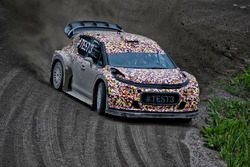The development of the 2017 World Rally car accelerates in Finland
The third development test session of its 2017 World Rally Car.

Photo by: Citroën Communication










Citroën Racing chose the roads of Finland for the third development test session of its 2017 World Rally Car. Running at maximum speed on the famous jumps, Kris Meeke and Craig Breen were able to test the car’s aerodynamic performance.
With its large, fast and rolling roads, Finland is among world rallying’s most revered venues. Due to the high speeds and the difficulty to “read” the road it is one of the toughest terrains to grasp, especially at the approach of the jumps that send the cars flying into the air.
So, it is no surprise that this country figures among the priority destinations for the team in charge of developing the Citroën that will compete in the World Rally Championship beginning in 2017. After the rough terrain of southern France and the mud-filled tracks in Portugal, Finland was ideal to continue assessing the car’s reliability and performance.
Vulnerability is an essential point in rallying.
Alexis Avril
For this test, the aerodynamics were closely scrutinized by the engineers. “The freedom allowed by the FIA regulations offers us a much larger range of possible solutions than before”, says project manager for the 2017 World Rally Car, Alexis Avril. “The bodywork of the WRC must entirely cover that of the original model and the maximum width is set at 1875 mm. In this framework, we have a lot of freedom to design the wheel arches and bumpers. We can also develop with the door posts, create air intakes for re-cooling the rear brakes and add on a diffuser… Paradoxically, there are more restrictions for the design of the rear wing than today, but its efficiency will be increased tenfold by its further backed and raised positioning.”
The aerodynamics of a race car must solve the complex equation of attaining maximum down-force, minimum drag and maximum cooling. To achieve this, Citroën Racing’s engineers have adopted what is now a standard methodology. “We started the work with the CFD calculations, which let us sift through the possible options, continues Alexis Avril. “We collaborated with the Citroën design studio in order for the race car to resemble the characteristics of the production model. From this data, we built a model that was used in the wind tunnel. Between sessions, we carried on with the CFD calculations in enriching the data from the tests, and vice versa. ”
With this approach, the expertise gained during the development of the WTCC Citroën Elysée has been widely put to use: “We have made great strides in our understanding of the flow principles and aerodynamic performance since 2013 and the debut of the WTCC programme. We have saved time in utilizing the proven solutions. As the disciplines are different not everything was transferable, in circuit racing, there is a form of systematization that doesn’t exist in rallying. Thus, the compromises are more important. ”
While the aerodynamic development itself was done with CFD calculations and wind tunnel tests, the test sessions were used to verify the resilience of the elements. “Vulnerability is an essential point in rallying. On the dirt, mud, stones and gravel can quickly tear away the element or block the air intakes…,” recalls Alexis Avril. “So you have to run in all the conditions to, once again, find a compromise between reliability and performance.”
Citroen Racing
Be part of Motorsport community
Join the conversationShare Or Save This Story
Subscribe and access Motorsport.com with your ad-blocker.
From Formula 1 to MotoGP we report straight from the paddock because we love our sport, just like you. In order to keep delivering our expert journalism, our website uses advertising. Still, we want to give you the opportunity to enjoy an ad-free and tracker-free website and to continue using your adblocker.















Top Comments